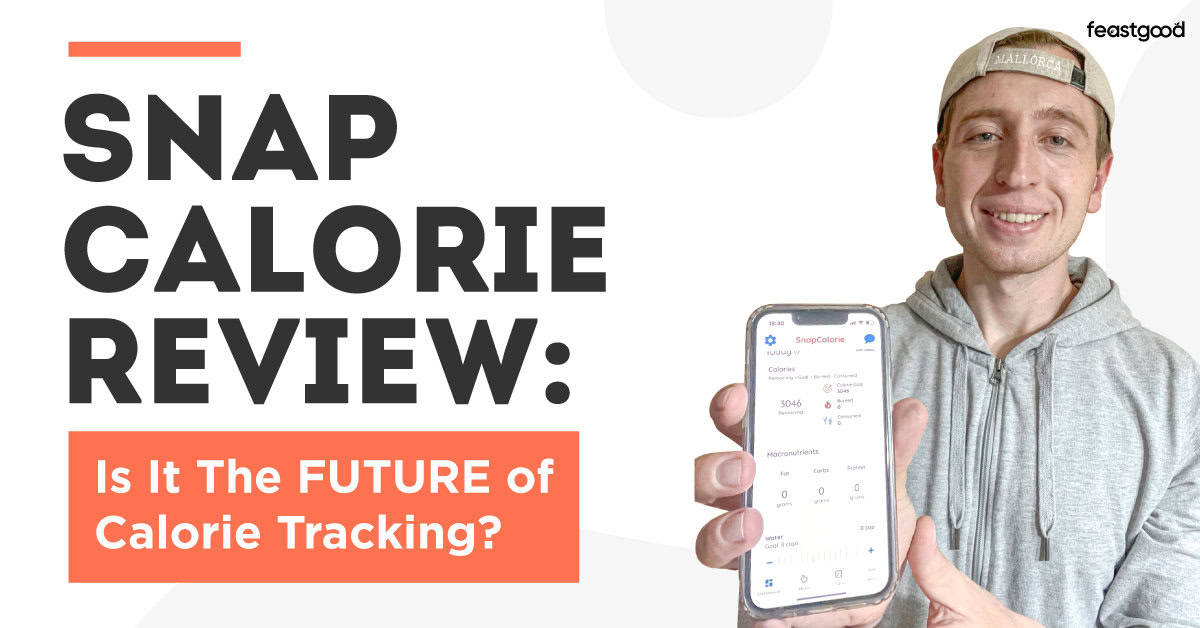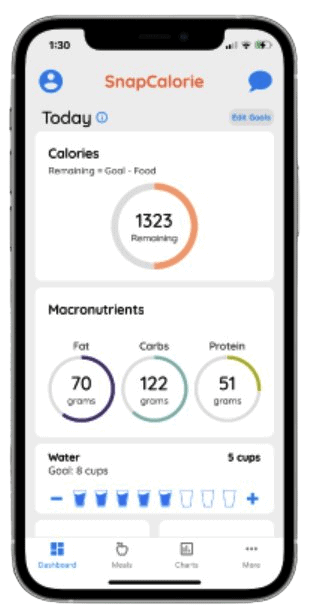Some links in this article are affiliate links, which means we earn from qualifying purchases. Learn more.
SnapCalorie’s main selling point is the ability to estimate portion sizes when food logging by simply taking a picture of your meal.
This isn’t the first time an app has claimed to have this sort of technology. FatSecret and Foodvisor have this feature, too, but after testing them, both were glitchy and had major accuracy issues.
So, I was highly skeptical that SnapCalorie could deliver its promise of “single picture calorie tracking.”
After testing SnapCalorie for the past month, here’s my quick take.
Key Takeaways
Honest Review Guarantee from FeastGood: Our testing team purchases each product 100% independently and uses the product for several weeks up to several months before writing a review. Learn more about our review process here.
- The “single picture calorie tracking” is not automated. After taking a picture of your meal, a person is assigned to review the photo and estimate the calories and macronutrients. While unique, this approach is time-consuming (results take 5 to 60+ minutes to arrive), and the results often require additional tweaking.
- SnapCalorie also allows you to log meals in several ways (outside of just taking a picture), and track water intake.
- When starting, SnapCalorie provides calorie and macronutrient targets based on gender, age, weight, activity level and goals. You can manually adjust your assigned goals or go through a survey to get updated recommendations.
- SnapCalorie’s food database is lacking, especially compared to big boys like Cronometer, Macrofactor, and MyNetDiary. I often got a single result from popular terms like ‘oatmeal.’ Also, the app doesn’t have a recipe database for the moment.
- After testing 18+ nutrition apps, my final verdict is SnapCalorie isn’t the best app on the market right now for calorie and macro tracking. I’d rather use MacroFactor instead. You can read my Macrofactor here if you want to learn more.
Medical Disclaimer: The content of this article is provided for educational insights only. It should not be used as medical guidance. Individuals with a past of disordered eating should refrain from weight loss programs or calorie tracking. For medical advice, consult a certified healthcare professional. If you’re struggling with eating disorders, contact NEDA for assistance.

My Opinion on SnapCalorie As A Personal Trainer
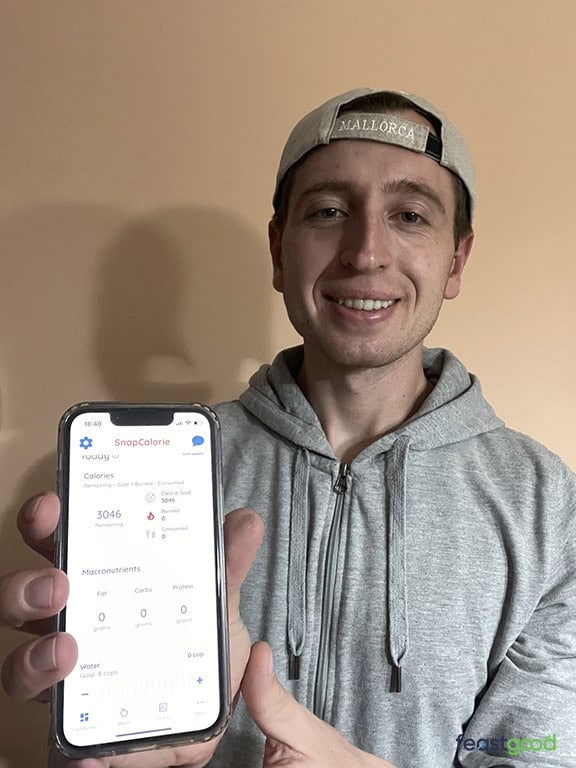
Using SnapCalorie was a bittersweet experience for me.
Even the things I like about the app come with caveats, which is frustrating.
For example, I liked that I could log my meals in several ways. However, I still found meal logging tedious and far too time-consuming.
I was often unsure what method to use and sometimes had to switch from one to the other because of the app’s unreliability.
One thing I liked was that I could edit my nutritional goals at any point. I could manually change my calorie and macro targets or go through the initial survey for the app to do the calculations for me.
However, when I went through the survey to see what the app would come up with, I noticed that:
- My initial calories seemed low for my weight gain goal
- Fat recommendations were high for some reason (90 grams; I prefer to keep them to around 70 grams, maximum)
- Protein was also high (230 grams, which is unnecessary at my body weight, especially in a calorie surplus)
On top of that, I couldn’t record anything besides my body weight.
The app didn’t allow me to log body fat percentages or circumference measurements or upload progress photos like I can on more sophisticated apps like MacroFactor.
The app didn’t allow me to track micronutrients (apart from sodium and cholesterol) or daily steps taken. I couldn’t select a preferred meal frequency and had to fit into the app’s mold of three meals plus a snack instead.
What I particularly didn’t like about the app was that the calories burned through physical activity were automatically added to my daily calorie allowance.
That option could be useful sometimes (for example, hiking once and burning many calories), but other apps handle it far better. For example, Foodvisor has a ‘Sports mode,’ where physical activity calories get added to my total. However, I can keep it turned off if I want to.
Overall, I can’t say that I’m a fan of the app’s current state or that I would recommend it to anyone––a friend, a fellow coach or one of my clients. Read on for more of my thoughts on SnapCalorie and why I ultimately came up with this verdict.
How Does SnapCalorie Work?
SnapCalorie is a nutrition app created to help people track their food intake, drink more water, record their physical activity and monitor their body weight.
The app provides nutritional targets for users based on individual factors like:
- Gender
- Age
- Body weight
- Height
- Activity level
- Goals (weight gain, loss, or maintenance)
Once you go through the survey, the app provides calorie targets and a macronutrient breakdown, which you can adjust if you’d like.
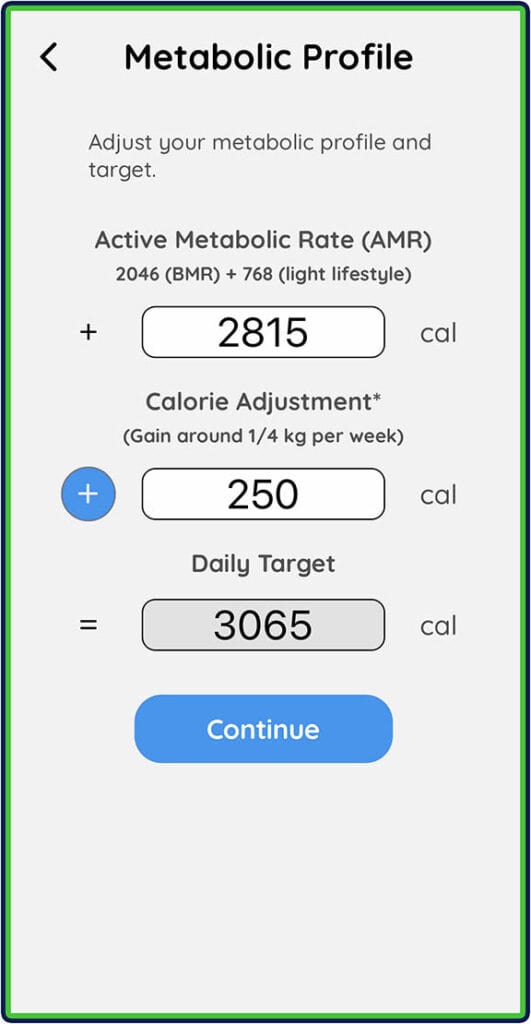
Your plan is then ready, and you can access your dashboard, where you can see your daily calorie and macronutrient goals, water intake and physical activities done, as well as sodium and cholesterol intake.
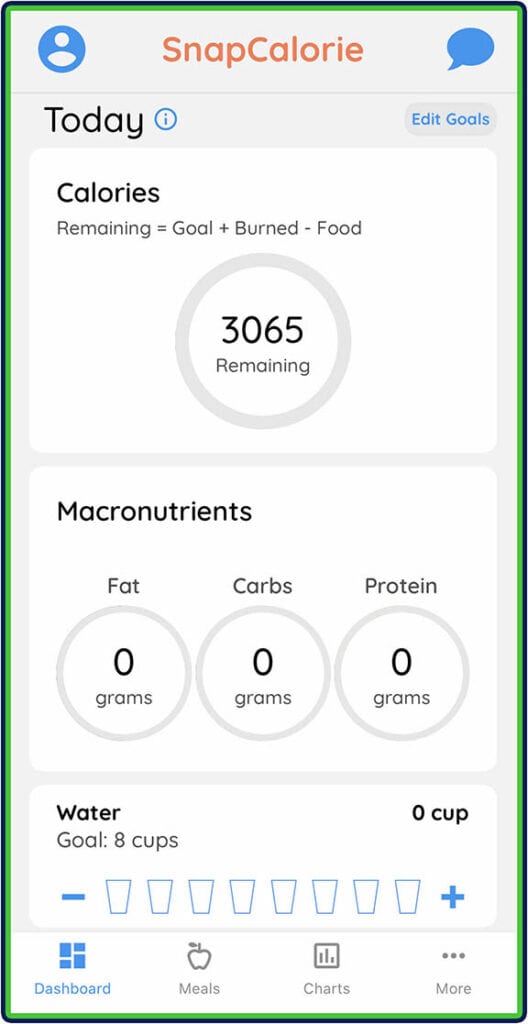
Users can log their body weight daily, set up reminders to log meals, adjust their calorie and macro targets and go through a list of written lessons.
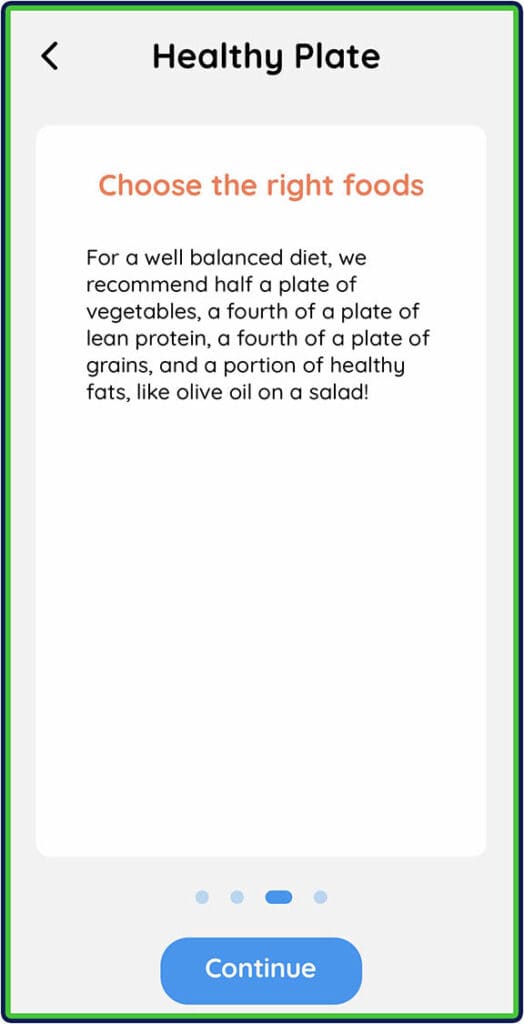
Key Features
- Log Meals by Taking Photos: Every photo log is reviewed by a person to increase accuracy when logging your nutrition.
- Adjustable Nutrition Targets: Manually edit your calorie and macro targets or take the initial survey again if you feel that your nutritional needs have changed.
- Log Physical Activity: Choose from an extensive list of activities, select the difficulty and add a duration. The app estimates your energy expenditure and automatically adds it on top of your daily calorie target.
- Chat With Snappy: SnapCalorie provides access to an AI chatbot powered by ChatGPT to answer simple and basic nutrition and exercise questions.
- Some Educational Resources: The app provides access to written lessons on nutrition, habits, hydration, brain health and healthy aging. Each lesson is brief and to the point.
What I Liked About SnapCalorie
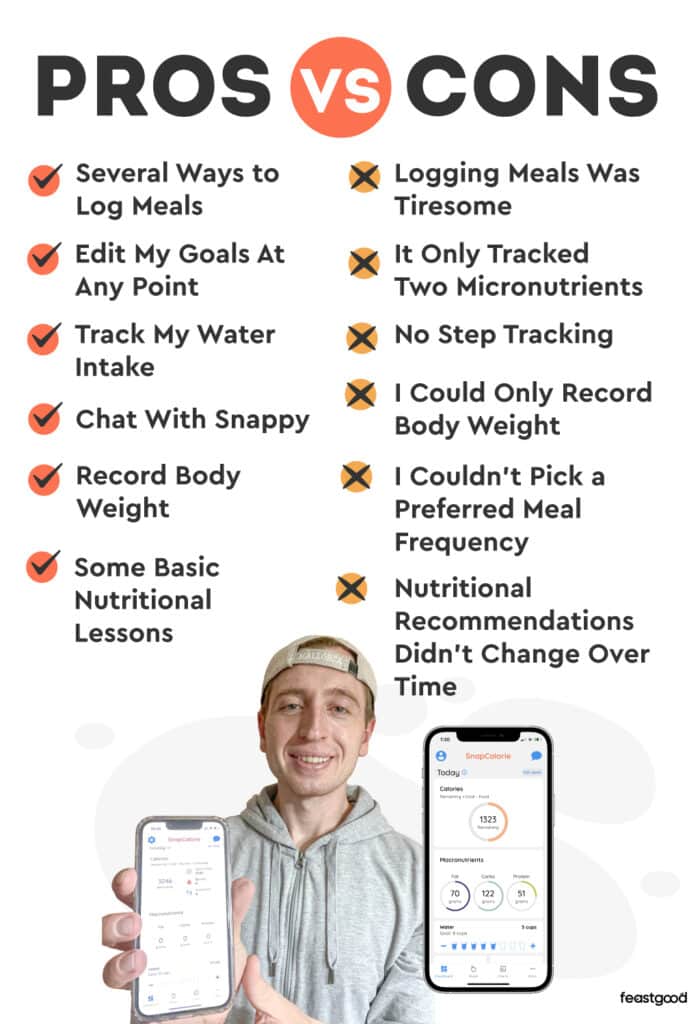
1. Several Ways to Log Meals
The first thing I noticed and liked about SnapCalorie is that I could log my meals in several ways:
- Text log – I could manually write the food and the amount. Once I click ‘Save Meal,’ the app automatically calculates the calories and macronutrients.
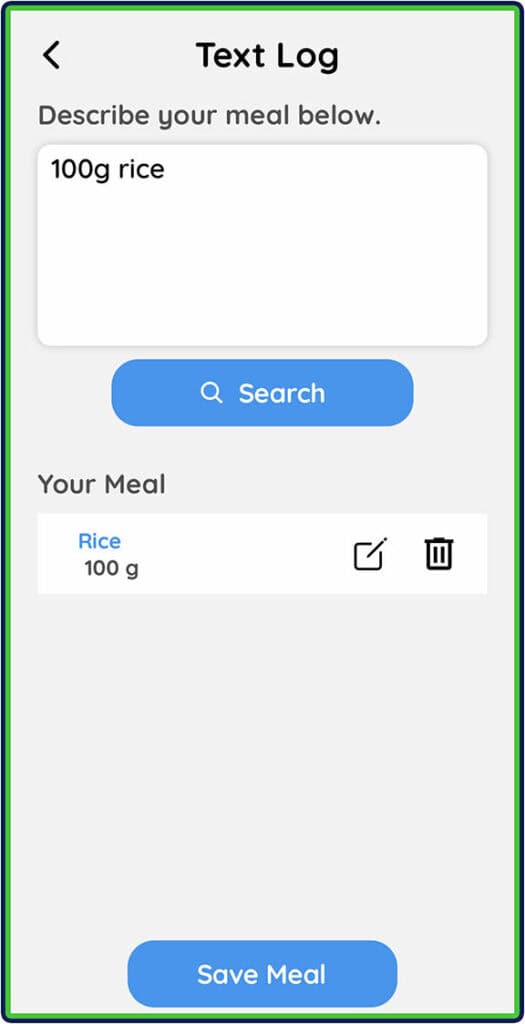
- Voice input – I could also push the microphone button on my keyboard and tell the app what foods I ate with the respective quantities. It worked as well as the text log feature and saved me a bit of time from typing.
I will note that results were entirely accurate when I said each word one by one as clearly as possible––for example, “Five. Ounces. Chicken. Breast.” The speech-to-text feature was less accurate when I spoke faster.
- Photo scan – this is the app’s main selling point, and I was curious to see how it worked. To my surprise, SnapCalorie did a fair job here, as I could take photos of meals and individual foods.
According to the app, a human reviewed my photos to guess what I ate and estimate the nutritional value. For the most part, the results weren’t bad and I got decent estimations (within 20-30 percent for caloric accuracy).
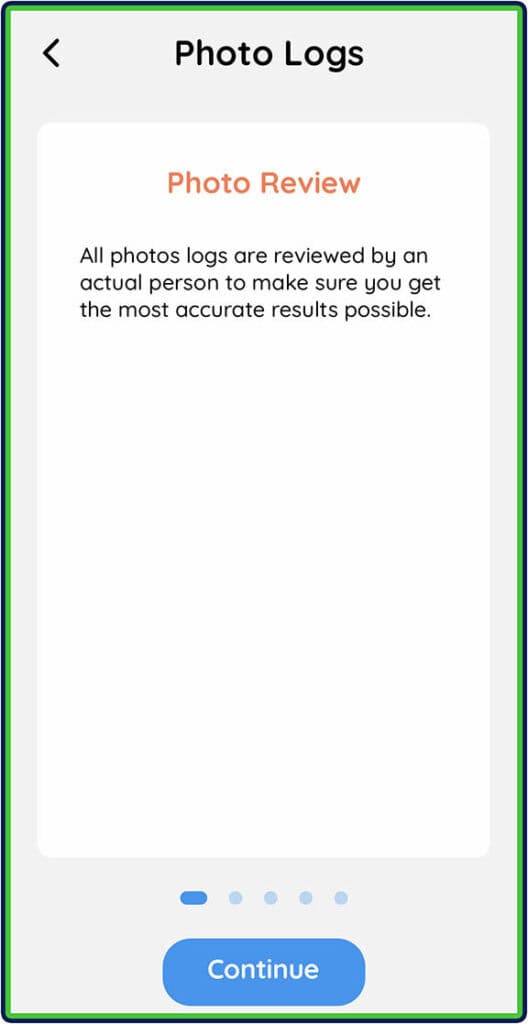
- Scan barcode – this is certainly not a new feature, but it’s nice to have. I tested it on various packaged goods, and it picked up the nutritional information.
- Favorite meals – the app allowed me to bookmark any meal I wanted into a ‘Favorite Meals’ category and easily log them. This was particularly useful because I often eat the same things every day, and it’s nice to have a simple way to essentially copy and paste.
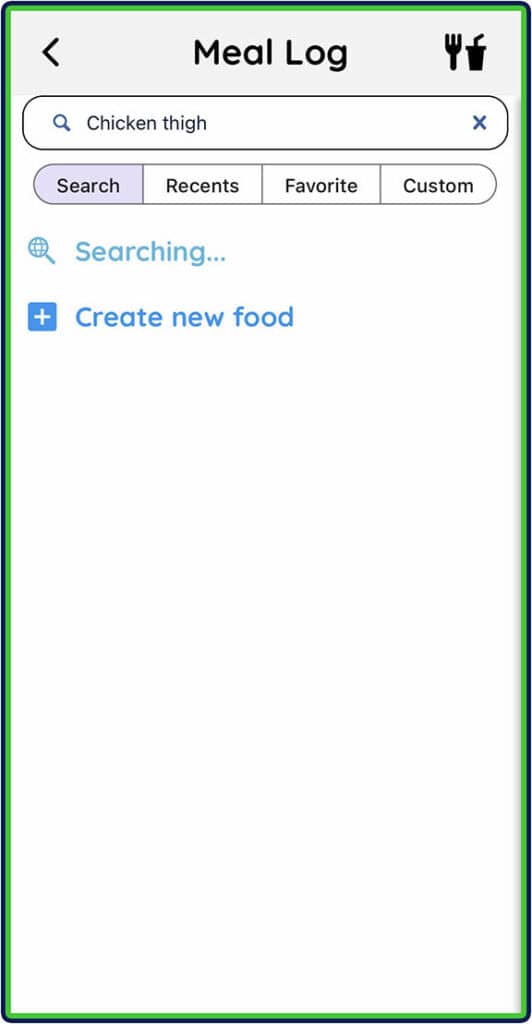
- Quick log – this was perhaps the most frustrating to use. I could search for foods in the database but found that most were missing. As such, I couldn’t reliably use the quick log feature and instead relied on barcode scanning, text and voice input and picking from previously saved meals.
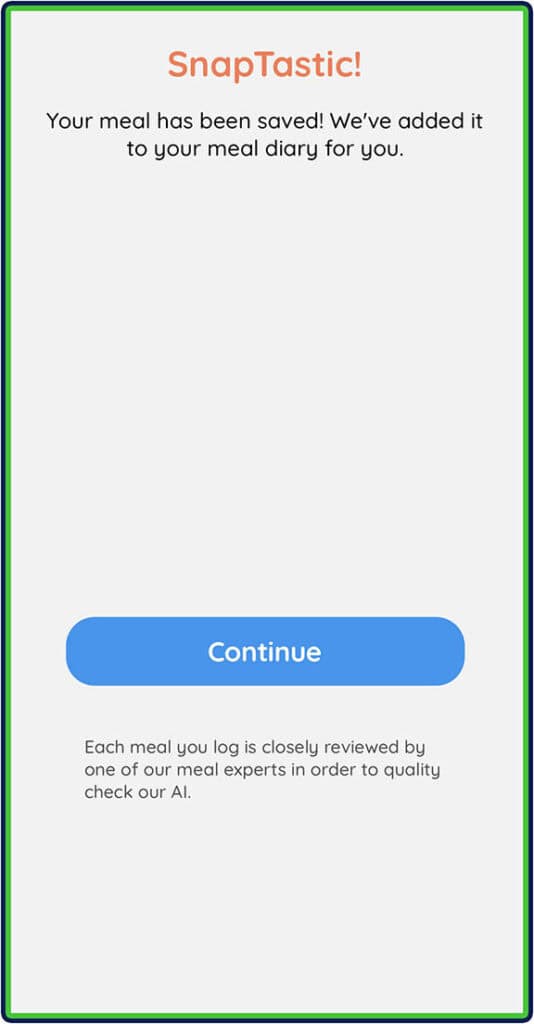
2. Edit My Goals At Any Point
SnapCalorie doesn’t have built-in coaching capabilities like MacroFactor (more on that later), but the ‘Edit Goals’ feature was useful.
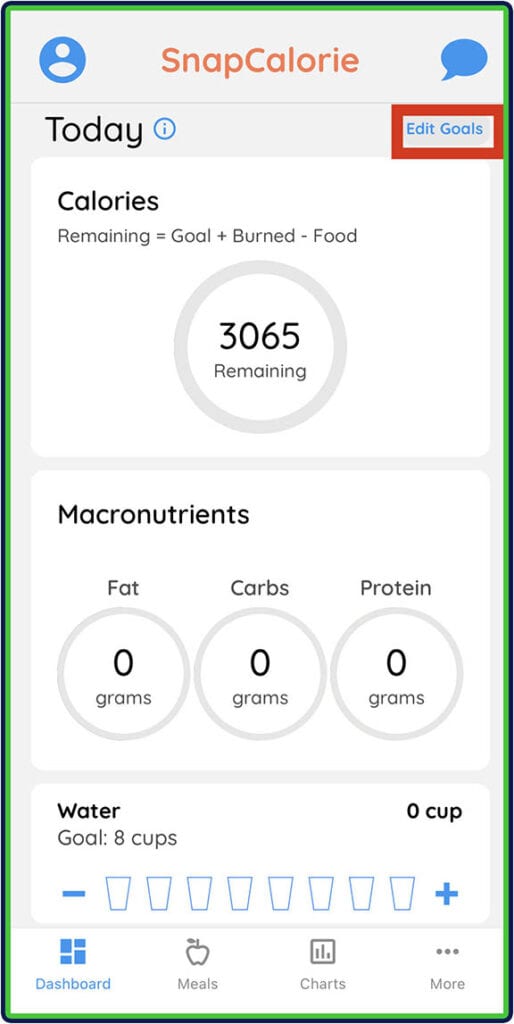
I could adjust my calorie and macro targets as I saw fit or go through the same survey I took during the signup process for the app to re-adjust my nutritional goals.
As an experienced trainer, the manual option worked fine because I’ve tracked my nutrition for years and understand how my needs change as I lose or gain weight.
However, someone with less experience might not know how to adjust their calories and macronutrients. In such a case, taking the survey again could be a decent alternative.
My critique for re-taking the survey is that I have to go through all the questions again, including those where my answer is unlikely to change––for example, what my height is.
3. Track My Water Intake
Another thing I liked about SnapCalorie was that I could easily log my water intake. All I had to do was scroll down just a bit on the dashboard, and I could use the small + sign on the right to add a cup of water.
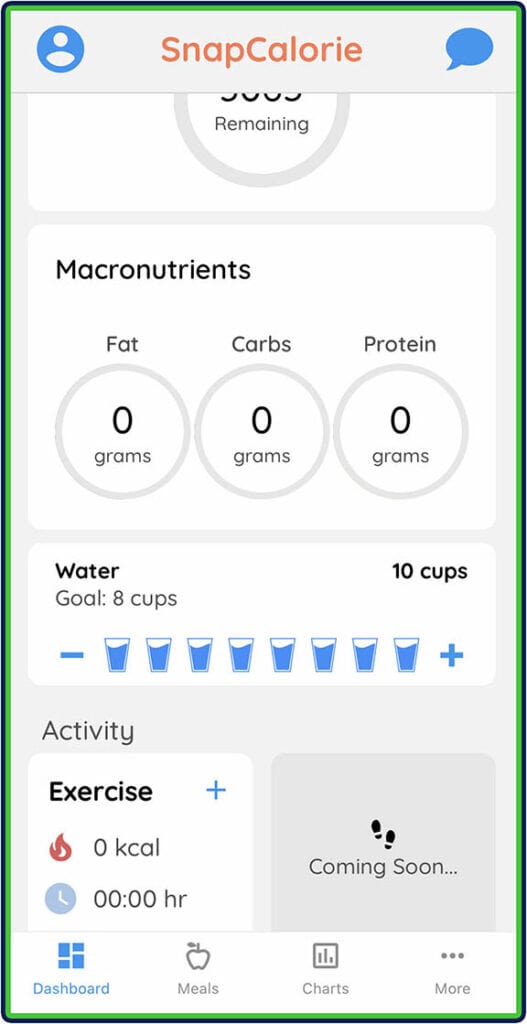
I’ve never had trouble drinking enough water, but I could see how this feature would be useful for someone who always forgets to drink water. Their daily water intake is visible as soon as they log in to the app.
It would have been nice to get reminders from SnapCalorie to drink water, but the app doesn’t have that. The only option is to set reminders to log meals at preferred times of the day.
4. Send a Daily Nutrition Email
SnapCalorie has a ‘Health Coach’ option that’s quite interesting. When I clicked on it, I could enter the email address of someone (for example, a coach).
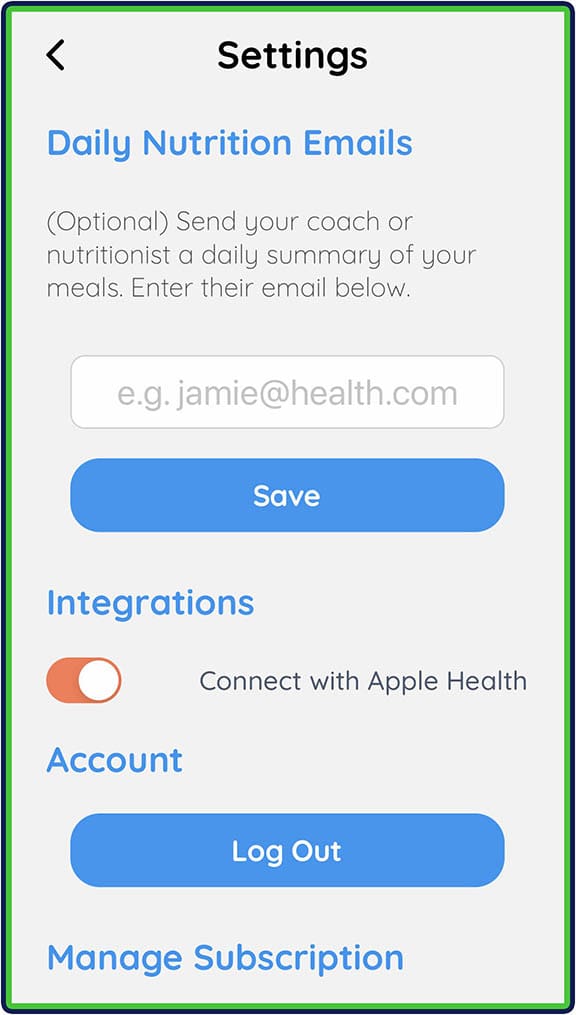
When I was finished logging my daily meals, the app would automatically send an email to the person I’ve chosen, detailing my meals, calorie intake, macros and other neat details.
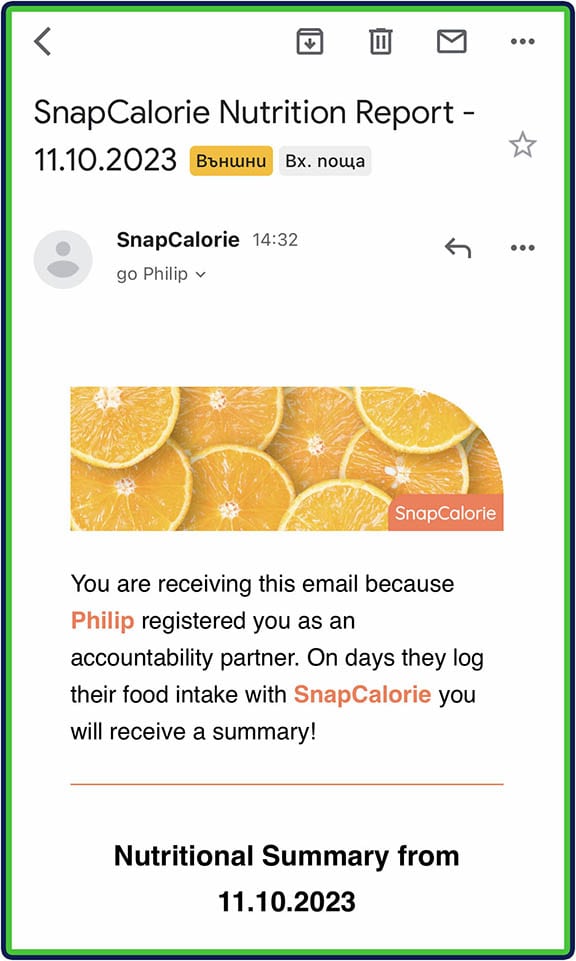
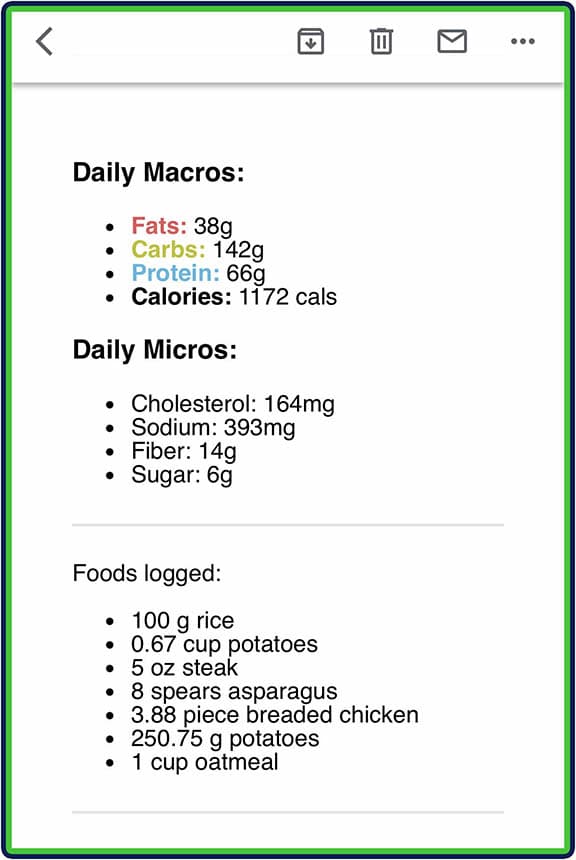
This is an excellent feature I’d love to see in other apps. It allows people to update their coaches seamlessly and stay accountable.
An option for a weekly update would also be nice. Rather than sending a nutritional update daily, summarize the week and send it over once––for example, on Sunday.
5. Chat With Snappy
Chat with Snappy is a built-in chatbot inside SnapCalorie powered by ChatGPT.
I could access it by clicking the blue chat icon on the top right of the dashboard. On the one hand, I liked the feature, and I admire the fact that the company is upfront about this being ChatGPT and not an actual human fitness expert.
The chat feature works fine for basic nutritional questions. For example, here is what Snappy responded when I asked, “How much protein should I eat to build muscle? I weigh 198 lbs.”
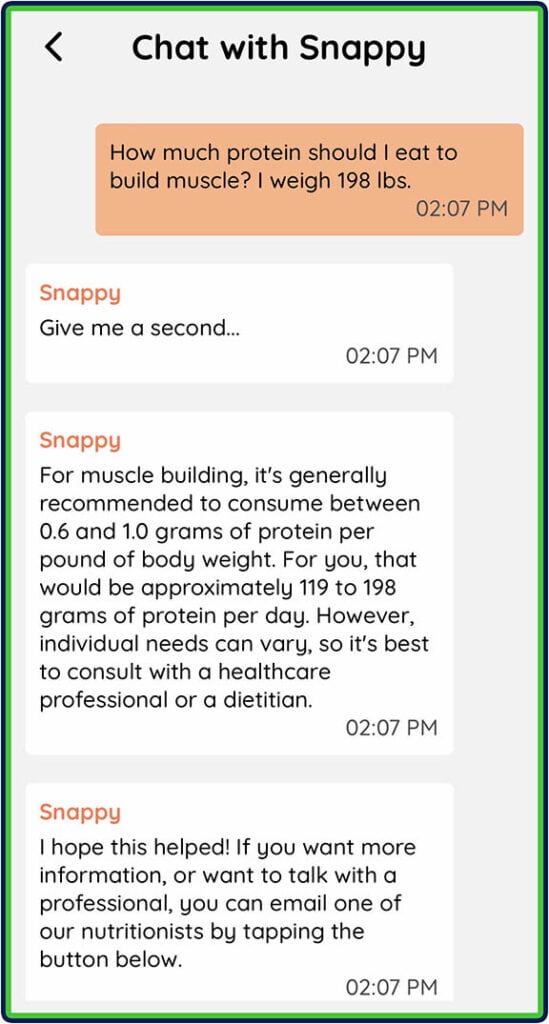
However, I’m not in love with the chat feature because it couldn’t provide helpful responses to more complex questions. As a chatbot, Snappy is incapable of nuanced thinking, empathy or solving more complex problems.
For instance, when I asked, “Can you please help me stop binge eating at midnight? I’ve tried all the popular tactics!” it responded:
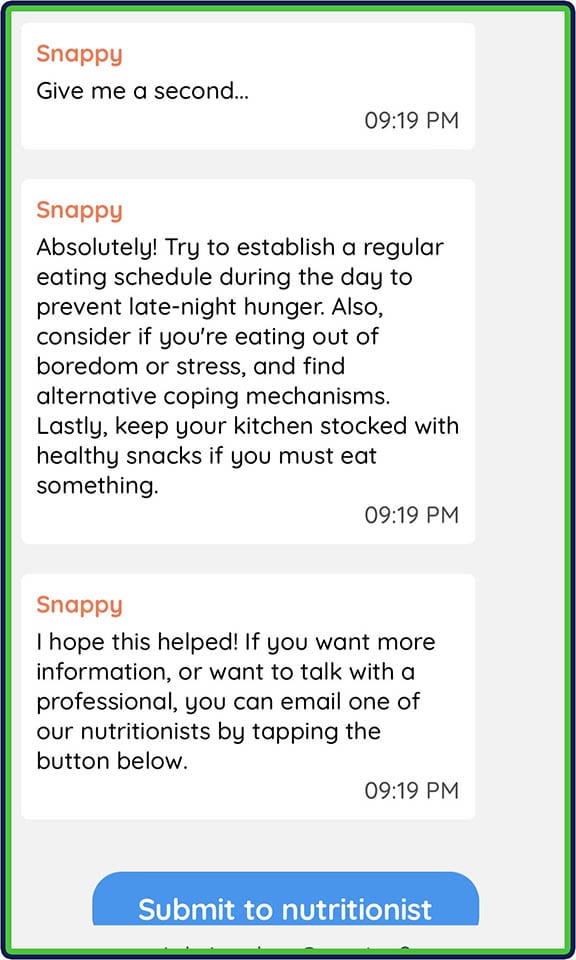
It’s not terrible advice, but it lacks empathy, isn’t very specific and none of the tips are unique.
6. Record Body Weight
Like pretty much all nutritional apps on the market, SnapCalorie allowed me to record my body weight.
To log my daily weigh-in, I had to click ‘More’ (bottom right corner) and ‘Weight Tracker.’ I could then record my weight, see my history and see the numbers on a graph. It’s nothing unique or groundbreaking, but it’s nice to have.
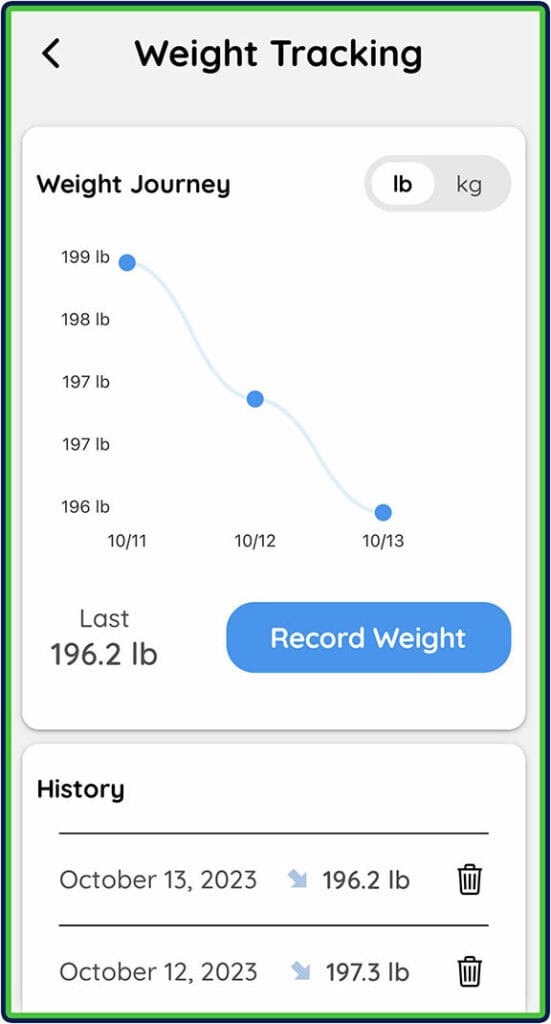
7. Some Basic Nutritional Lessons
SnapCalorie comes with a small library of written lessons I found useful. I could access them by clicking ‘More’ on the bottom right corner and navigating to ‘Lessons.’
The first lesson was an introductory guide to SnapCalorie––what the app is, how it works and other helpful info. Below that, I could learn about:
- NutriScore – how the app calculates the nutritional score of various foods
- Snappy – what this chat feature is and how it works
- What a healthy plate is (and what it looks like)
- The importance of hydration
- How food and lifestyle affect brain health and overall cognition
- Key principles for healthy aging
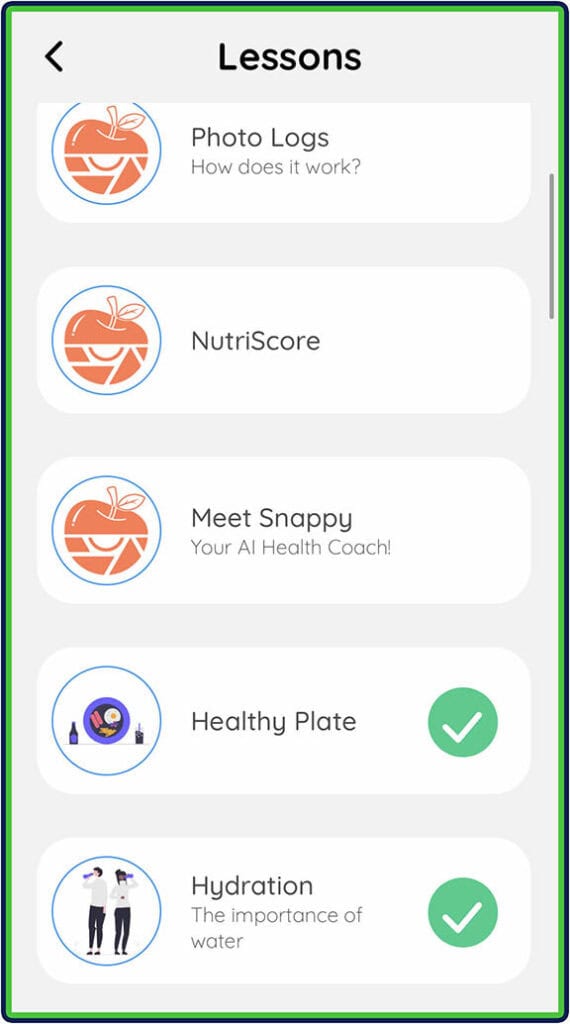
For the most part, the lessons were good and provided some information that could be quite useful for people just getting started with nutrition.
Some lessons can also be valuable for people who eventually want to stop tracking their nutrition with an app and move to a more intuitive eating approach. The ‘healthy plate’ lesson is a prime example.
I also enjoyed that the lessons were short and to the point. However, one critique is that the content could have been more actionable.
For example, when discussing the adverse impact of chronic stress, they could have included a few specific tactics for managing it instead of simply writing ‘stress management techniques like meditation and deep breathing can help..’
What I Didn’t Like About SnapCalorie
1. Logging Meals Was Tiresome
Despite having multiple ways to log meals, I found the experience tiresome and somewhat time-consuming.
First, having multiple ways to log meals isn’t necessarily better. I often found myself wondering how exactly to log a meal before eating. “Should I take a photo? Or perhaps weigh my food and input it manually?”
The photo-taking feature wasn’t bad, but I felt it was far from reliable, so I did not use it that much. It worked like this:
- I would take a photo of my meal.
- The meal would get the status ‘Pending.’
- I would get a nutritional breakdown later (usually within 10 to 20 minutes, but it sometimes took longer than an hour).
- I’d have to look at the results and make changes (add/remove foods, change quantities, etc.).
- I would save the meal and go about my day.
I don’t know about you, but it feels like a lot of work to log a meal.
Even after going through the process, I never felt entirely sure my photo-logged entries were accurate. As someone with years of experience weighing foods and tracking macros, I found it much easier to simply weigh foods and input them manually.
The only use for the feature I can think of right now is if I’m having a meal outside and don’t want to log it right away. I can snap a quick photo of my meal when I’m served, enjoy it in peace and record it later.
Additionally, SnapCalorie’s food database is lacking. I often got just one search result, even when looking up popular options like oatmeal or oats.
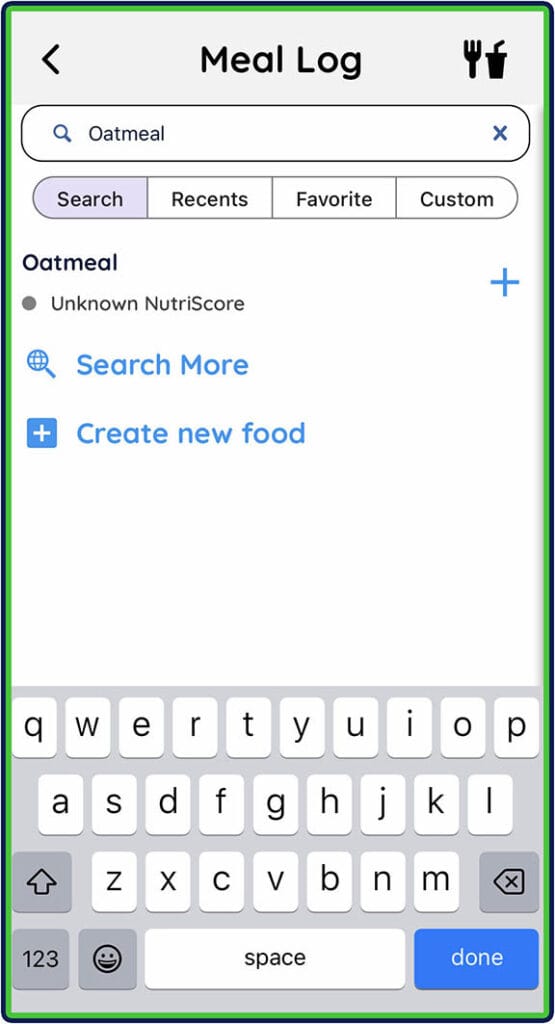
I like what they are trying to do with the ‘photo is reviewed by an expert’ feature, but it makes meal logging a drag because you have to wait for their analysis, which can take 5 minutes or over an hour.
That said, their estimations based on photos I took of meals were somewhat good. Plus, I could add/remove foods, change the quantity if I disagreed and submit feedback to help them improve. I think this feature is going to get better with time.
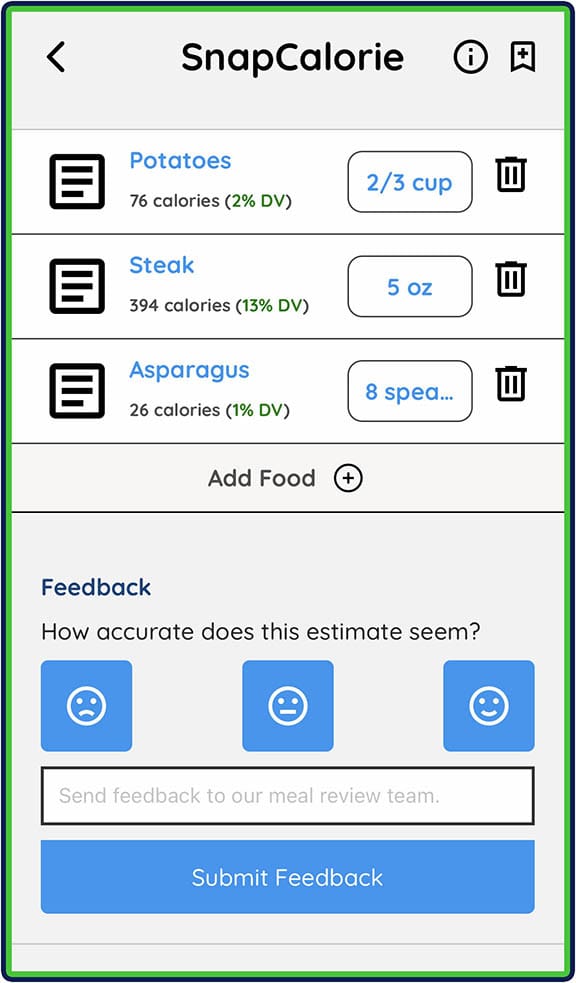
Overall, I often had to switch between logging options, and it took me longer to record my meals than with other apps.
2. It Only Tracked Two Micronutrients
The app only displayed my sodium and cholesterol intake in the dashboard. My daily targets were 2,300 mg of sodium and 300 mg of cholesterol, both of which align with the general recommendations.
While it’s great to track both for health reasons, especially in people at risk of cardiovascular disease, it would have been great to track other minerals and the 13 vitamins.

3. How Activity Logging Works
SnapCalorie allowed me to input my activity level by clicking the small + icon under ‘Activity’ in the dashboard. I could pick from many alphabetized options or use the search field at the top to save time.
Some entries, such as weight lifting, are categorized based on effort––for example, vigorous workout (burning 6.3 calories per kilogram per hour) or light workout (burning 3.1 calories per kilogram per hour).
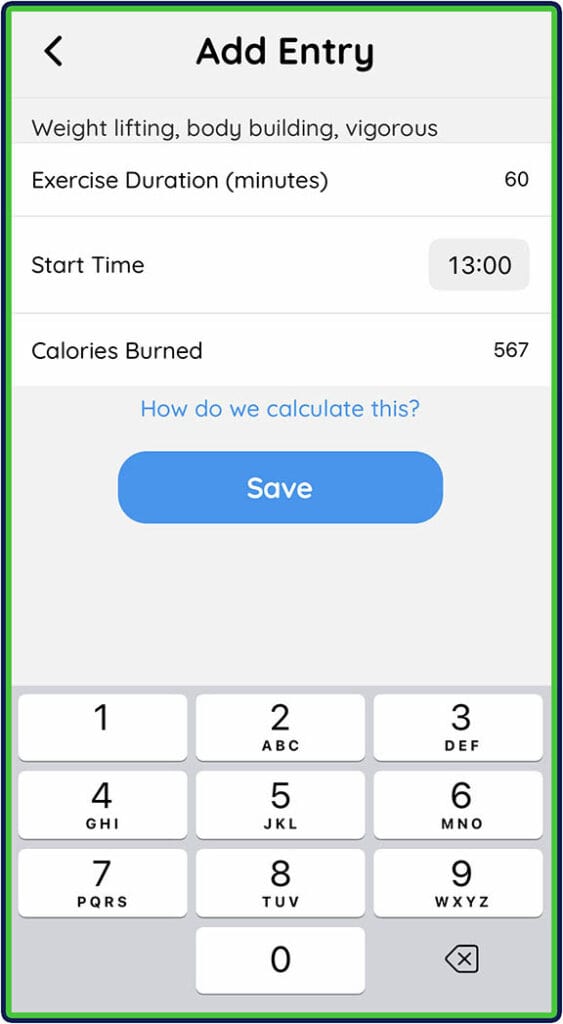
Once I selected an activity, I could add a duration in minutes, and the app automatically calculated my calories burned.
The feature is similar to the one offered on Foodvisor (you can read my review of that app here), apart from one thing.
With Foodvisor, I could turn ‘Sports mode’ on, which added calories burned through physical activity to my total (TDEE). For example, if my daily calorie target was 2,600 and I burned 500 calories by running, my allowance would increase to 3,100. However, I could also keep it disabled if I wanted to.
SnapCalorie doesn’t provide that option. Any activity I logged was automatically added to my daily total, which I didn’t like. It made me less likely to log my activity in the app because my daily calorie allowance increased significantly.
A better approach for most people is to calculate calorie needs and account for activity level instead of adding every calorie burned during exercise to one’s already established daily total. That way, the daily calorie targets are more consistent and align with the person’s needs.
4. No Step Tracking
Despite integrating with Apple Health, SnapCalorie doesn’t offer step tracking, which I found somewhat disappointing.
I’ve come to expect that feature from nutrition apps because it makes it easier to oversee my nutrition and get a rough estimate of my daily activity in one place.
That said, there is an icon for step tracking with the text ‘Coming Soon..’ in the dashboard, which means the feature is likely in the pipeline.
5. I Could Only Record Body Weight
Another thing I found frustrating about SnapCalorie is that I could only record my body weight.
It’s a nice feature, but that metric alone is not enough to tell if I was progressing well toward my goal.
For that, it would have also been nice to be able to record my body fat percentage, circumference measures (chest, arms, waist, thighs, etc.) and possibly even upload progress photos for convenience.
6. I Couldn’t Pick a Preferred Meal Frequency
The strange thing about SnapCalorie is that it never asked me about my preferred meal frequency. Instead, it assumed I was a “3 meals plus a snack” kind of guy and ran with that.
When I clicked on the Meals tab at the bottom, I was presented with options to log:
- Breakfast
- Lunch
- Snack
- Dinner
That frequency is not bad and will probably work fine for most people. However, those eating more or less frequently might struggle to log their nutrition effectively.
For example, someone eating six meals a day would have to combine certain meals and snacks to fit into the mold offered by the app.
One good thing is that the app doesn’t force me to log food in each meal to complete my day and send my email report to my coach or accountability partner. I could only log lunch and dinner if I wanted to.
7. Nutritional Recommendations Didn’t Change Over Time
Built-in coaching capabilities are a relatively new addition to nutritional apps, but we’ve grown to expect them.
When I use MacroFactor or Carbon Diet Coach, my nutritional targets gradually adjust based on weight trends, body fat percentage changes and other factors. However, SnapCalorie doesn’t offer the same feature. I got my initial targets by answering a few questions, and that was it.
That said, the app allowed me to edit my calorie and macro targets manually. I could use a third-party calorie calculator and change macro values at will.
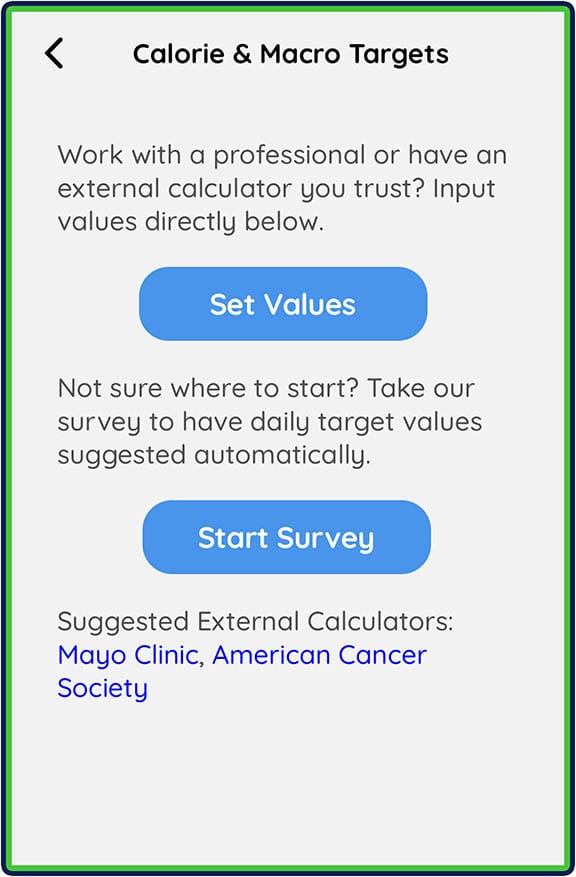
Interestingly, if I reduced my protein or fats without changing my calories, the app wouldn’t automatically decrease my overall calorie target or increase my carbs.
Instead, I had to manually calculate the grams for each macronutrient by calculating the nutritional value (four calories per gram of carbs and protein and nine grams per gram of fat).
For example, I reduced my fats from 90 to 70 grams and protein from 230 to 200 grams. To get my carb target, I had to subtract 630 (the calories from fats) and 800 (the calories from protein) from 3065 (my daily calories).
I then divided the value by four to get my new carb target of 409 grams (previously 345 grams).
This is by no means difficult, but it takes experience. I can see how someone new to calorie and macro-tracking would get confused and mess up with their nutritional targets.
What Other Customers Think
SnapCalorie has a 4.5-star rating on the App Store with just over 60 reviews. Some positive reviews revolved around the ability to snap a photo of a meal, get a rough estimate of the nutritional value and loosely track calories without manual inputting.
Users also liked the ability to easily review past meals, serving as a photo journal. Some users also praised the app for its simple and intuitive interface.
Negative reviews of the app often revolved around the inaccuracy and general unreliability of the photo-logging feature. Users often reported that the process was time-consuming, and they often had to describe the meal and make adjustments following an expert’s analysis.
SnapCalorie’s Google Play rating is far lower at just 3.5 stars, with around 80 reviews. In some positive reviews, users praise the app for its simplicity and the ability to log meals by taking photos.
However, many criticize the app for its ineffective photo-logging, bugs and inability to test the camera features without paying.
Who Should Use SnapCalorie?
- People who want to update their coach or accountability partner daily through email
- Those who want to log their meals in several ways, depending on what they are eating and where they are
Who Should NOT Use Foodvisor?
- Those looking for built-in coaching capabilities and adaptive nutritional targets
- Folks who want to track all micronutrients for health and wellness reasons (Cronometer is an excellent alternative)
- Users who want to track more than just body weight
- Users looking for a reliable and accurate way to log meals with photos/using the camera
- People who want rich and accurate food and recipe databases to look up nutritional information and get meal ideas
Sign Up For SnapCalorie
The first thing I noticed was that SnapCalorie doesn’t have a Gmail or Facebook login. Instead, I had to manually write my name, email address and password to create an account.
Once inside, I had to confirm my email address with a code they sent me. Then, I had to go through a brief sign-up process and tell the app a bit about myself:
- Gender
- Age
- Weight
- Height
- Activity level (ranging from mainly sitting to highly active)
- Weight goals (gain, lose, or maintain weight)
From there, the app gave me an initial caloric estimation, which I found to be a bit low, even for the rate of weight gain I had picked (gain ¼ kilogram per week).
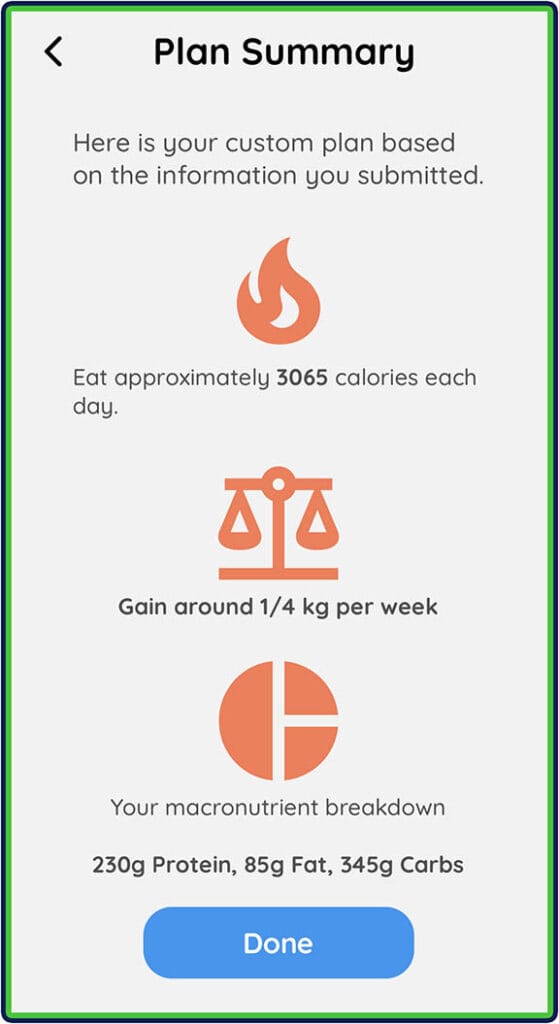
Next up, there was the macronutrient distribution. I could manually adjust my macro percentages with a slider or pick from popular options: balanced, keto, high protein and low carb.
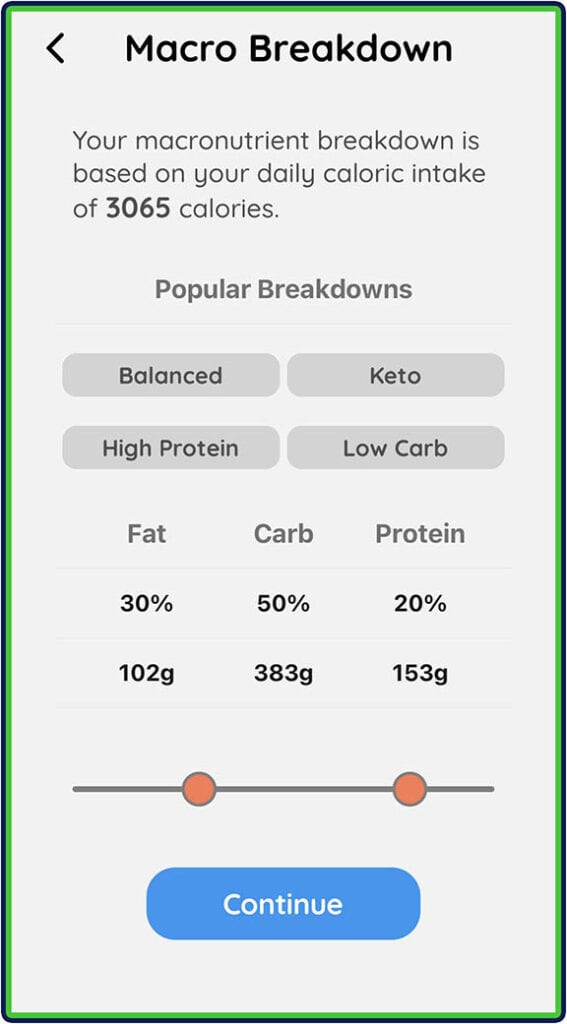
From there, I could pick whether to display or hide calories and macronutrients on the dashboard and I was good to go.
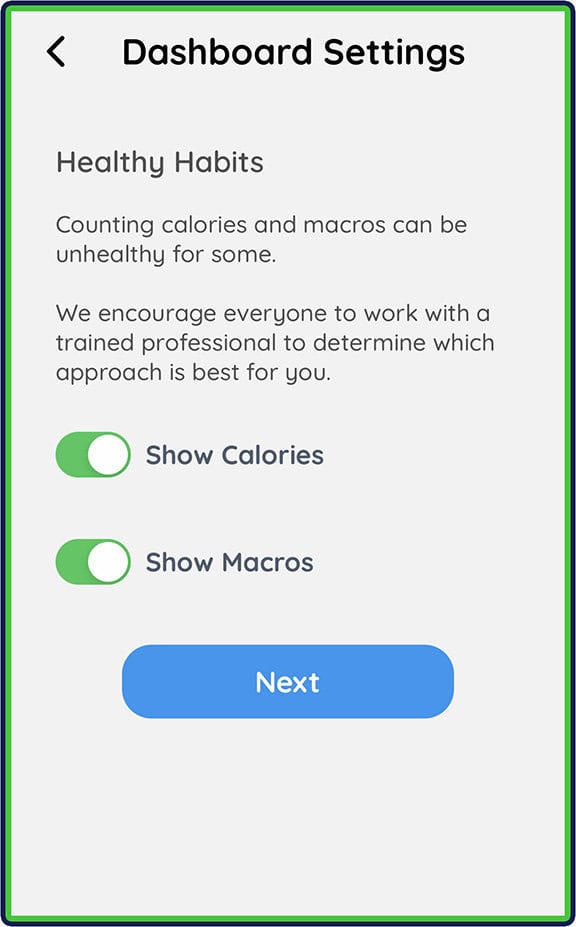
The setup process took about five minutes, and SnapCalorie generated nutritional targets I could aim for immediately.
SnapCalorie Alternatives
MacroFactor
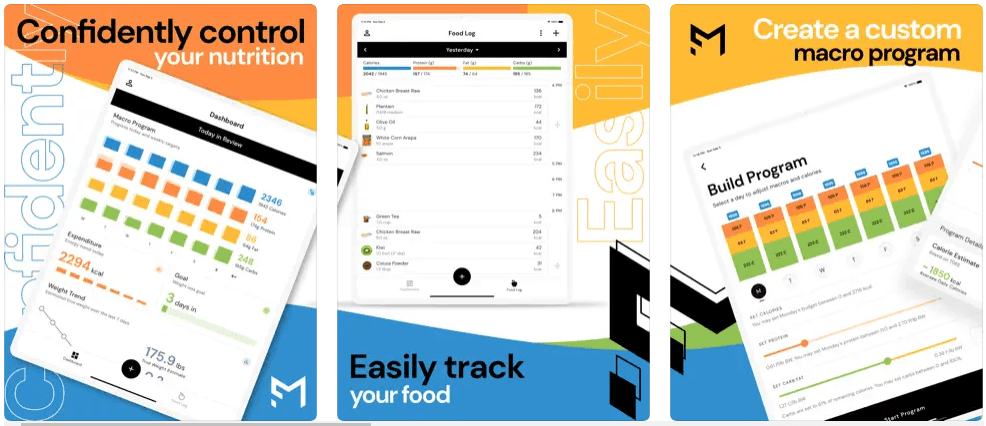
MacroFactor is somewhat similar to SnapCalorie because it gathers information from users to provide nutritional recommendations. Users can then log their meals in several ways.
That said, MacroFactor is more sophisticated in several ways. It updates users’ nutritional targets based on weight trends and other factors, the food database is far larger and more detailed, and users can record body fat percentage and circumference measures, as well as upload progress photos.
Read our full MacroFactor review.
Enter code FEASTGOOD when signing up to get an extra week on your free trial (2 weeks total). Cancel any time before your trial ends without being charged.
Foodvisor
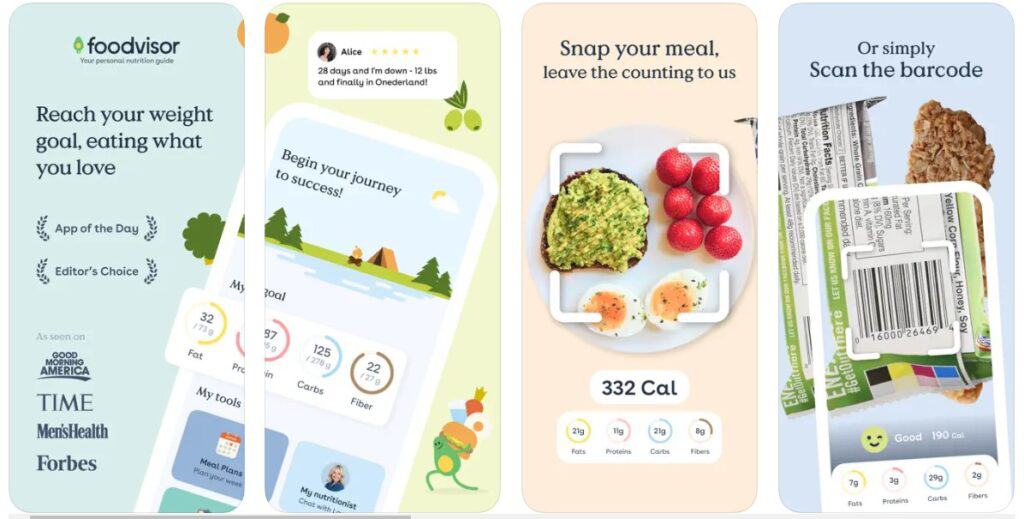
Foodvisor is an app that allows users to track their nutrition, chat with their assigned nutritionist, and dive into health and nutrition lessons.
The app’s food database is much better, and it gives users access to plenty of healthy recipes, each with an in-depth nutritional breakdown.
Foodvisor is an excellent alternative to SnapCalorie because it also has a photo-logging feature. Users can point the camera to their meals, and the AI begins to guess what’s on the plate, estimating the amounts and nutritional values.
Read our full Foodvisor review.
Frequently Asked Questions
How Much Does SnapCalorie Cost?
SnapCalorie offers a 14-day free trial. The cost afterward is:
- Monthly Payments: $30
- Annual Plan: $150
Is SnapCalorie Good For Weight Loss?
The app can help users track their nutrition somewhat accurately to create and sustain a calorie deficit for weight loss. That said, there are better alternatives like MacroFactor and Noom.
Is SnapCalorie Compatible With the Apple Watch?
At the time of writing this (October 2023), SnapCalorie is not compatible with the Apple Watch.
How Do I Cancel My SnapCalorie Subscription?
Go to ‘More,’ click on ‘Settings,’ and navigate to ‘Membership Management.’ The app takes you to the subscription tab of the App Store, where you can review or cancel your subscription.
How Do I Contact SnapCalorie?
There is a blue chat icon on the top right side of the dashboard. Click on it, then select ‘App Questions’ to submit your message to the team behind SnapCalorie.
About The Author

Philip Stefanov is a certified conditioning coach, personal trainer, and fitness instructor. With more than nine years of experience in the industry, he’s helped hundreds of clients improve their nutritional habits, become more consistent with exercise, lose weight in a sustainable way, and build muscle through strength training. He is passionate about writing and has published more than 500 articles on various topics related to healthy nutrition, dieting, calorie and macronutrient tracking, meal planning, fitness and health supplementation, best training practices, and muscle recovery.
Why Trust Our Content

On Staff at FeastGood.com, we have Registered Dietitians, coaches with PhDs in Human Nutrition, and internationally ranked athletes who contribute to our editorial process. This includes research, writing, editing, fact-checking, and product testing/reviews. At a bare minimum, all authors must be certified nutrition coaches by either the National Academy of Sports Medicine, International Sport Sciences Association, or Precision Nutrition. Learn more about our team here.
Have a Question?
If you have any questions or feedback about what you’ve read, you can reach out to us at [email protected]. We respond to every email within 1 business day.
